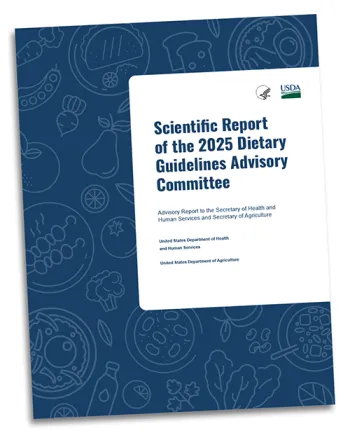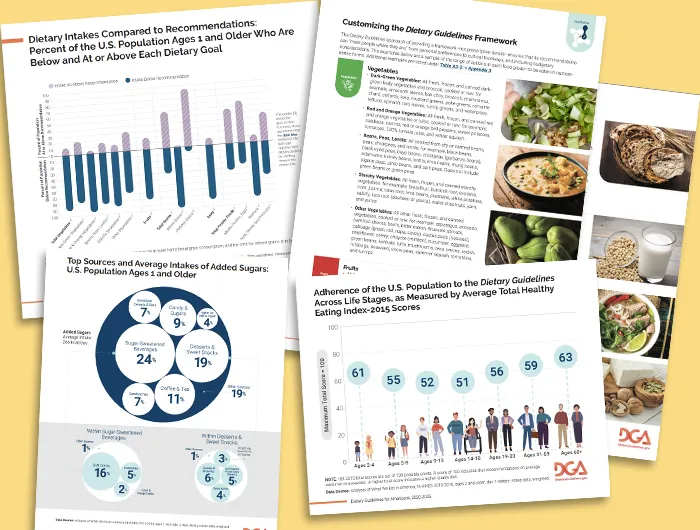How are the Dietary Guidelines developed?

Mangostar - stock.adobe.com.
We all have had the experience of trying to figure out what foods we should eat to stay healthy. Is a glass of wine okay? What about eggs, olive oil, red meat, or whole milk? And if it’s so confusing to decipher all that for just yourself and your family, how does anyone figure it out for the whole country? We’ll introduce you to the experts who handle that work and tell you how they do it.
Need a primer on the Dietary Guidelines? We’ve got you covered.
Developing the Dietary Guidelines
The Dietary Guidelines for Americans are developed through a multi-step, evidence-based process overseen by the U.S. Department of Agriculture (USDA) and the Department of Health and Human Services (HHS). The Guidelines are updated every five years to reflect the latest high-quality science. During each round, USDA and HHS choose topics for review and appoint an independent panel of 10-20 experts outside the government called the Dietary Guidelines Advisory Committee.
What is the Dietary Guidelines Advisory Committee?
The Dietary Guidelines Advisory Committee (DGAC) produces the “Scientific Report,” which they present to the Secretaries of Agriculture and Health and Human Services after two years of work. USDA and HHS consider the recommendations from the report as they write the final Guidelines.

Committee members are typically an impressive bunch. They often have decades of experience in research, teaching, or practicing medicine, and they hold advanced degrees in relevant topics like nutrition, biology, and public health. They are nominated by members of the public and by professional organizations. Experts who are interested in serving can also nominate themselves. To be nominated, a potential committee member must have more than ten years of experience related to at least one of the topics that will be examined and an advanced degree in nutrition or a related field. The committee members are also chosen to reflect a diversity of points of view and expertise. For the 2025 – 2030 Guidelines, a total of 20 scientists were appointed to the Committee, following a rigorous interview process by USDA and HHS staff.
It’s also worth noting that the Committee members don’t make any money from their work in this role—it's all done on a volunteer basis.
How does the Advisory Committee evaluate evidence on nutrition?
Before the scientists are even appointed to the DGAC, the work is already piling up for them because the previous Committee has made suggestions about what they’d like to see explored in the next cycle. Questions for the Committee to address may also come from comments made by members of the public. The potential questions are evaluated on whether they’re relevant to the goals of the Guidelines, their potential public health importance, and possible impact to federal programs (for more information on that, check out our article on the purpose of the Guidelines.)

For 2025, the Committee was charged with considering the following questions:
- What are the current intakes of food groups, nutrients, and dietary components?
- What is the current prevalence of nutrition-related chronic health conditions?
- What is the relationship between dietary patterns consumed and risk of cardiovascular disease?
- What is the relationship between dietary patterns consumed and risk of cognitive decline, dementia, and Alzheimer's disease?
- What is the relationship between food sources of saturated fat consumed and risk of cardiovascular disease?
Once they are named to the Advisory Committee, the scientists begin their work by dividing into subcommittees, each of which is responsible for evaluating the evidence related to a specific topic. These subcommittees bring the results of their work back to the full Committee, which comes to a consensus on the topics in public meetings. (For transparency reasons, the Committee can come together as a full group only during meetings that are open to the public.) They use that consensus to write the full Scientific Report.
To answer the questions they’ve been asked to consider, the subcommittees rely on a variety of tools. For some questions, like those about what people are eating these days, the Committee directs federal staff scientists to perform an analysis of the data. The Committee is responsible for reviewing and approving the analysis plan, then reviewing and evaluating the reports that the federal staff scientists write. The scientists use data from several sources, including the National Health and Nutrition Examination Survey, which involves interviews with roughly 10,000 members of the public per two-year cycle about what they eat, or the National Health Interview Survey, which records how many people in the United States are living with various diseases and health conditions.
They also conduct systematic reviews, a type of study that requires reading all the relevant and recent peer-reviewed literature on a topic, evaluating the quality of each study, and using the important data from each one to build a consensus. Systematic reviews usually take months for a team to complete, but they’re considered the gold standard when it comes to evaluating the scientific evidence on a complicated topic.
The systematic reviews conducted by the DGAC are particularly trustworthy because they are carried out and reviewed by a large group of scientists from different backgrounds. The group includes USDA staff from the Nutrition Evidence Systematic Review team, a group of public health and nutrition scientists with advanced training in conducting systematic reviews. The involvement of several DGAC members, plus the expertise from NESR scientists, limits the risk of an individual member’s bias shaping the final recommendations. Translation: No single member of the Committee can sway the outcome of the Scientific Report.
How rigorous is the process of evaluating evidence?
Reviewing the evidence takes the Committee around two years, in part because there’s so much to consider and because it’s a very rigorous process.
For example, let’s get into the details of the systematic reviews—fasten your seatbelts, this is where things get really exciting!
First, the subcommittees conducting those reviews must decide on inclusion criteria,
which determine what studies are going to be included in the review, what health outcomes they’ll consider, and how they’re going to analyze the data and draw their conclusions. All those details—or protocols, as they’re called—are available to the public (including, of course, nutrition researchers and other experts) and, critically, they’re available before the review even starts so that the public can comment on them. Those protocols are helpful in telling us how rigorous the process will be. Having them available means that the Committee members are not picking and choosing studies with findings that a given member would like to include in the Scientific Report. Instead, the protocol decides exactly what studies will be included and why, and we can check the results of the completed systematic reviews against the protocol to be sure the working groups did exactly what they said they’d do.
As they review all the included studies on a given topic, Committee members evaluate the quality of each one in a process known as a risk of bias assessment. Once those deliberations are finished, they are ready to write the results and conclusions for the systematic reviews, which summarize the findings of all the studies and evaluate how strong the entire body of evidence is.

When they’re ready, the working groups present the results of their systematic reviews to the other members of the DGAC for discussion. At this point, the systematic reviews go through a process called peer review, where federal scientists (e.g., researchers working at the National Institutes of Health or the Centers for Disease Control and Prevention), expert reviewers, and members of previous Committees pore over the systematic reviews with a fine-tooth comb, making sure the working groups did the best job possible. The final systematic reviews are then published online so that they become part of the official documentation of the DGA review process.
No wonder the process of updating the DGAs happens every five years—it takes a long time to be sure that the work is being conducted as rigorously as possible, but this rigor is why the DGAC report is one of the best summaries of nutrition science we have.
How can the public get involved in the work of the Advisory Committee?
In addition to nominating scientists to serve on the Advisory Committee, members of the public can provide comments on the topics the Committee will consider. Through the entire review process, starting when the Committee is appointed, anyone can submit written comments and attend public meetings to give oral comments. This includes CSPI: We nominated ten people to the 2025 Advisory Committee, six of whom were selected, and we submitted comments on the proposed scientific questions, the draft systematic review protocol, and the Committee’s Scientific Report. During the process of developing the 2025 update to the Guidelines, the DGAC, USDA, and HHS received nearly 10,000 comments from the public and held 7 public meetings, all of which were open to the public via webcast.
What about transparency?
Those public meetings might be a little dry for most people, but they’re also a great opportunity to pull back the curtain and understand how the Advisory Committee does its job. You can watch Committee members describe the studies they’ve reviewed before the whole committee dives in to ask questions and evaluate the evidence together.
You can also read the entire Scientific Report, although it might take you a while; this cycle’s edition runs 421 pages. But that’s for a good reason—the Committee members show their work! Not only does it include all the big-picture recommendations for what makes a healthy diet, it also provides the background on how the DGAC came to its decisions, including a lot of information about the research the subcommittees conducted and all the recommendations they are making to USDA and HHS.
When the Committee has finalized its report, it sends it to both USDA and HHS, who publish the Scientific Report and solicit comments from the public. Historically, the departments review the Report and use it as their framework to update the Guidelines. We don’t know what the process will be for the upcoming version of the Guidelines, which is due to be released by the end of 2025. But given how frequently anti-scientific ideas, misunderstandings of how science works, and myths about the Guidelines are espoused by important figures like Health and Human Services Secretary Robert F. Kennedy, Jr., we will be keeping a close eye on whether the 2025 Guidelines fly in the face of scientific consensus and ignore the rigorous work done by the Committee.
How can the process of developing the Dietary Guidelines be improved?
As rigorous as the process of updating the Dietary Guidelines is, there’s always room for improvement. One important change would be requiring Advisory Committee members to publicly disclose any potential conflicts of interest. In fact, the National Academies of Sciences, Engineering, and Medicine have been calling for just that since 2017. Disclosing conflicts of interest is important because it’s critical to build public trust in the people tasked with answering important questions about health and nutrition. Although the most recent DGAC provided information on funding sources and other potential conflicts of interest, the information was published in aggregate. So there’s no way to tell which member (or members) received funding from, say, the National Cattleman’s Beef Association or the Egg Nutrition Center (actual funders listed in the published disclosure document).
Transparency is important because it builds trust in public health institutions, which has been hard to come by lately. Food, nutrition, and public health have become increasingly political, making it critical that people working in the field are as forthcoming as possible about potential conflicts of interest, which will help ward off attacks from bad-faith actors who are seeking to smear the Committee members and their work.
Staffers at HHS and USDA are currently reviewing the Scientific Report and putting together the Guidelines. But because that process happens behind closed doors, it’s impossible for the public to know how the agency is developing the Guidelines. Which parts of the Scientific Report are they including (or ignoring) and why? Are there talks with members of industry that may weaken the recommendations? Is anti-science rhetoric shaping the outcome? For an administration that claims to value transparency and gold-standard science, now is their chance to prove it to the American people.
Key takeaways
- The process historically employed by the Dietary Guidelines Advisory Committee for evaluating evidence is thorough and reliable. That said, there are open questions for nutrition scientists to research. As they do, we expect that the rigorous process implemented by the DGAC will continue prioritizing the highest quality research findings to produce reliable, evidence-based dietary guidance.
- Just as with any process, the DGA process can be improved. How? All members of the Dietary Guidelines Advisory Committee should be required to submit conflict-of-interest statements that disclose their relationship with the food industry. And those disclosures should be made publicly available for each individual member.
- It's likely that the Guidelines will diverge from the Scientific Report this year, as Secretary Kennedy has stated the new DGA will "stress the need to eat saturated fats, dairy, good meat, fresh meat and vegetables." The Guidelines are due to be out by the end of 2025. As always, you can trust that CSPI will be keeping close track of what those Guidelines say (and don’t say) and what that means for your and your community’s health.
CSPI is your food & health watchdog
We envision thriving communities supported by equitable, sustainable, and science-based solutions advancing nutrition, food safety, and health.
As a nonprofit organization that takes no donations from industry or government, CSPI relies on the support of donors to continue our work in securing a safe, nutritious, and transparent food system. Every donation—no matter how small—helps CSPI continue improving food access, removing harmful additives, strengthening food safety, conducting and reviewing research, and reforming food labeling.
Please support CSPI today, and consider contributing monthly. Thank you.

Stirring the Pot
Join the fight for safer, healthier food
Sign up to receive action alerts and opportunities to support our work in Stirring the Pot, our monthly newsletter roundup.

